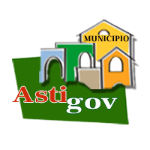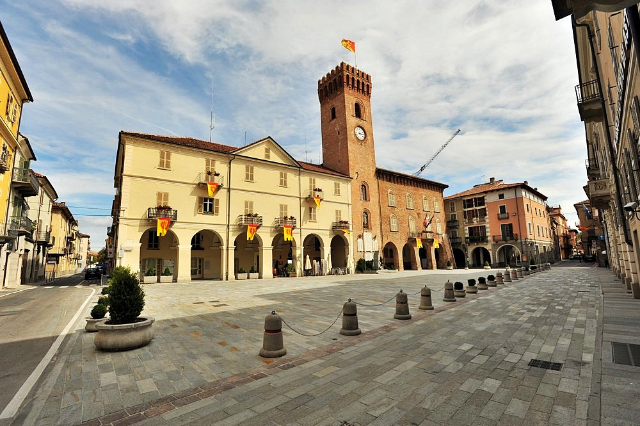Nizza Monferrato
Last update 30 January 2024
Nizza is… The lion of Monferrato conquers the eyes of the world from the top of the Campanone
Landscape
Nizza Monferrato lies in southern Astigiano.
It is about 25 km from Asti, the provincial capital.
History
Nicea Palearum or della Paglia, today's Nizza Monferrato, was founded in the year 1225.
Nizza's history is marked by sieges: mention is made of the one in 1268 carried out by the troops of Charles of Anjou and, again, the one from May 12 to 24, 1613 by the troops of Duke Charles Emmanuel I of Savoy, which saw the Nicesi victorious.
Nizza came under the rule of, among others, the Gonzaga, and Savoy families.
Important was the government exercised by the Crova family, barons of Vaglio and lords of Nizza.
A pivotal figure in the history of Nizza Monferrato is that of the knight Pio Corsi di Bosnasco who, as mayor, provided a great impetus to the development of the city by carrying out significant public works.
For more information: Nizza Monferrato's Tourist Information and Reception Office
Insights
Baldino, Giuseppe. “Cenni storici”. Città di Nizza Monferrato, Mar. 16, 2017, www.comune.nizza.asti.it/it/page/cenni-storici-11e97009-6fb9-4ff9-855a-792b02092fe6. Last accessed Jan. 27, 2024.
Administration
The title of city was conferred on Nizza Monferrato, in 1703, by Duke Ferdinand Carlo Gonzaga.
Food and wine and typical products
Nizza Monferrato is recognized all over the world as the capital of Barbera wine.
From the appreciated grape variety, the Barbera d'Asti superiore “Nizza” appellation was born on July 1, 2016.
An opportunity to taste Nizza and other Piedmontese types of Barbera is during the Nizza è Barbera festival, in May.
Nizza is also the land beyond comparison of the hunchback thistle (cardo gobbo) and white truffle, specialties that can be tasted during the St. Charles Patronal Fair (Fiera Patronale di San Carlo) and Truffle and Hunchback Thistle Day (Giornata del Tartufo e del Cardo Gobbo), in November.
Furthermore, it cannot be forgotten that Nizza is the home of the prized Piedmontese breed meat, celebrated during the Fat Ox and Beef Fair (Fiera del Bue Grasso e del Manzo).
Typical dishes include: green cake, which can be enjoyed during the Fair of the Holy Christ (Fiera del Santo Cristo), in April; belacauda (chickpea porridge); and bagna cauda, which characterizes two popular events: the Bagna Cauda del Camperista and Nizza è Bagna Cauda.
Insights
“Calendario delle Fiere e delle Manifestazioni”. Città di Nizza Monferrato, Dec. 28, 2023, www.comune.nizza.asti.it/it/page/calendario-delle-fiere-e-delle-manifestazioni. Last accessed Jan. 27, 2024.
To be seen
The territory of Nizza Monferrato is distinguished by many monuments of considerable artistic value.
You cannot miss a visit to the symbol of the town, the Campanone, a civic tower incorporated into the Civic Hall.
Historical buildings also include Palazzo Crova di Vaglio, Palazzo del Gusto and Palazzo De Benedetti.
Equally, interesting are the ecclesiastical properties: cannot be missed the Church of Our Lady of the Snow (or of the Bricco) — Chiesa della Madonna della Neve (o del Bricco), the Church of St. John the Baptist in Lanero (Chiesa di San Giovanni Battista in Lanero), considered the Duomo of Nizza Monferrato, the Church of St. Siro (Chiesa di San Siro) and the Church of St. Hippolytus (Chiesa di Sant'Ippolito).
The museum proposals are also stimulating with the Bersano Museum of Peasants and Old Wine Prints (Museo Bersano delle Contadinerie e Stampe Antiche del Vino), Sug@r(T)_house, the museum dedicated to sugar, and the permanent exhibition Art '900, a collection of works by Davide Lajolo.
A stop on the tourist itinerary should also be reserved for the jewish cemetery and the Garden of the Righteous (Giardino dei Giusti) (the only one in southern Piedmont).
Photography lovers should stop at the Artist's wings (Ali d'artista), artistic canvases depicted by large angel wings posted on the external walls of the gardens of Palazzo Crova.
Insights
“Art '900 - Collezione Davide Lajolo di 100 opere di arte contemporanea”. Città di Nizza Monferrato, Nov. 5, 2020, www.comune.nizza.asti.it/it/page/art-900-collezione-davide-lajolo-di-100-opere-di-ar. Last accessed Jan. 27, 2024.
“Calendario delle Fiere e delle Manifestazioni”. Città di Nizza Monferrato, Dec. 28, 2023, www.comune.nizza.asti.it/it/page/calendario-delle-fiere-e-delle-manifestazioni. Last accessed Jan. 27, 2024.
“Il Giardino dei Giusti”. Città di Nizza Monferrato, Jul. 2, 2020, www.comune.nizza.asti.it/it/page/il-giardino-dei-giusti. Last accessed Jan. 27, 2024.
“Palazzo Crova”. Città di Nizza Monferrato, Nov. 3, 2020, www.comune.nizza.asti.it/it/page/palazzo-crova. Last accessed Jan. 27, 2024.
“Palazzo del Gusto”. Città di Nizza Monferrato, Nov. 3, 2020, www.comune.nizza.asti.it/it/page/palazzo-del-gusto. Last accessed Jan. 27, 2024.
“Punti di Interesse”. Città di Nizza Monferrato, www.comune.nizza.asti.it/it/point-of-interests. Last accessed Jan. 27, 2024.
Curiosity
Signs of the siege suffered by Nizza Monferrato in 1613 are still visible on the outer masonry of the Campanone.
Insights
“Il Campanon (El Campanòn)”. Città di Nizza Monferrato, www.comune.nizza.asti.it/it/point-of-interest/721691?category_id=318944. Last accessed Jan. 27, 2024.
Data source
- Synthesis / reprocessing information taken from the institutional website (current and previous versions) of the City of Nizza Monferrato — https://www.comune.nizza.asti.it/
- Cover image source: City of Nizza Monferrato — https://www.comune.nizza.asti.it/
Insights
BeWeb - Beni Ecclesiastici in WEB
https://beweb.chiesacattolica.it/
Catalogo Generale dei Beni Culturali
https://catalogo.beniculturali.it/
Ente Turismo Langhe Monferrato Roero
https://www.visitlmr.it
Wikipedia, l'enciclopedia libera.
https://it.wikipedia.org
- Nizza Monferrato
https://it.wikipedia.org/wiki/Nizza_Monferrato
See also
News from Nizza Monferrato
- Discover the latest news posted on the website of the Municipality of Nizza Monferrato
https://www.comune.nizza.asti.it/it/news
Events in Nizza Monferrato
- Discover the events posted on the website of the Municipality of Nizza Monferrato
https://www.comune.nizza.asti.it/it/events
Social network | City of Nizza Monferrato
Follow your Municipality on social media:

